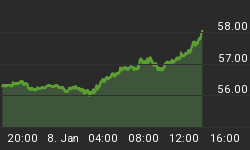Here's a look at the future action of the market.
Dear Speculators,
I apologize for the delay this morning - vacationed in an area with no internet access. I'm back now, so on to the charts.
Of course, if you have any additional questions, please feel free to email me at jay@stockbarometer.com.
Dynamic Trading Signals are based on a series of Oscillators tuned to the short and intermediate term movement of the market. Our goal is to be in the market at all times and switch from bearish to bullish positions in line with the markets movements (except for the Options service, which is subject to greater volatility and time decay). Periodically we will go to cash and await the next system trade.
DYNAMIC TRADING OSCILLATOR

Discussion: The positioning of this indicator is relatively high, and indicative of a short term top. However, the timing of actual tops is more determined by short term intra day indicators that we'll get into in our Summary.
10/20/40 WEEK CYCLE
The following chart shows our 10/20/40 week cycles. The 40 week is also referred to as the 9-month cycle. Cycles are not short term tools for determining precise entry and exit points, they're primarily used for intermediate or longer term positioning and forecasting.

INVESTOR'S INTELLIGENCE BULL BEAR SPREAD
Each week, Investor's Intelligence polls a number of newsletter writers. The poll results in a number of bullish advisors and a number of bearish advisors. The difference between those two numbers produces the following chart. It's believed, that when a majority of newsletter writers (like us) are bullish, that the market is near a top, and vice versa. The direction of this line is as critical as the level.

EQUITY INDEX OPTION VOLUME RATIO
The market is all about risk, and there are two primary classes of participants in the market, the individual investors and the institutions. Individuals primarily trade equity options and institutions primarily trade index options. So the relationship between the two gives us an idea of how much risk the individual is willing to take on. At tops, the individual tends to take on too much risk, making this indicator rise. At bottoms, the individual is usually washed out of the market, making this indicator fall.

QQQQ v. SPY RELATIVE STRENGTH
Risk tells us a lot about the market. This indicator looks at risk from another perspective. When market participants overall increase their willingness to take on risk, it's bullish for the market. That risk shift is shown on the above chart as a shift in relative strength from the Nasdaq to the NYSE. Note when we refer to Nasdaq, we're primarily looking at the QQQQ - since that's the focus of our service. And when we say NYSE, we look at the SPY.

MONEY FLOW
This indicator looks at the flow of money in and out of various investment vehicles. For the most part, when money flow reaches an extreme, in either buying or selling, the market is at a top or a bottom, respectively.

NDX CHART

In summary:
Dynamic Trading remains on its current SELL SIGNAL.
The positioning of Oscillator 1 and the fact that the chart is positioning for 60-min rsi sell signal (although not part of the DT system, this would be incorporated in the basis of a day trading system I've been developing) I think the market will start selling off very soon - if not today, then early tomorrow.
Looking at the intermediate term indicators, we have mixed signals at best. So whether or not this next decline is going to turn into something larger, we'll have to see how it sets up once the selling commences (which again, while sending this intra day - should be soon.)
Best regards and good trading!
















